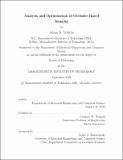Analysis and optimization of occluder-based imaging
Author(s)
Yedidia, Adam(Adam B.)
Download1227782274-MIT.pdf (23.15Mb)
Other Contributors
Massachusetts Institute of Technology. Department of Electrical Engineering and Computer Science.
Advisor
Gregory W. Wornell.
Terms of use
Metadata
Show full item recordAbstract
Occluders, i.e. opaque objects, can be used in the apertures of cameras to supplement or replace a traditional lens. This thesis describes a novel mutual information-theoretic framework for analyzing and comparing occluders. It justifies the use of uniformly-redundant arrays (URAs), a popular choice of occluding pattern in coded-aperture imaging. This thesis shows these patterns to be optimal under ideal conditions using this framework. Outside of those ideal conditions, this thesis proposes a method for selecting between different URAs and compares it to other occluder-selection methods, such as a greedy search, identifying under which conditions each is preferable. It also shows, analytically and empirically, the superiority of designed occluding patterns like URAs to random occluding patterns. The mutual-information theoretic framework is compared to a similar, MSE-minimizing framework. This thesis also considers the use of occluders in the context of non-line-of-sight (NLoS) imaging, used as "accidental cameras." The idea of the accidental camera is to opportunistically make use of occluding objects that happen to be available as ad-hoc coded apertures. Methods of this class, having originally been developed by Torralba and Freeman in 2012, are extended in this thesis to a wide variety of different scenarios, and used to solve formerly unsolved NLoS problems. These include imaging around a corner using the corner as the occluder, imaging a light-field of an unknown scene using a known, calibrated occluder, and imaging an unknown scene using an unknown occluder. The tools of the aforementioned framework are used to draw tentative conclusions about NLoS imaging systems, including resolution limitations due to longer light wavelengths and the quality of reconstructions across different systems.
Description
Thesis: Ph. D., Massachusetts Institute of Technology, Department of Electrical Engineering and Computer Science, September, 2020 Cataloged from student-submitted PDF of thesis. Includes bibliographical references (pages 229-237).
Date issued
2020Department
Massachusetts Institute of Technology. Department of Electrical Engineering and Computer SciencePublisher
Massachusetts Institute of Technology
Keywords
Electrical Engineering and Computer Science.